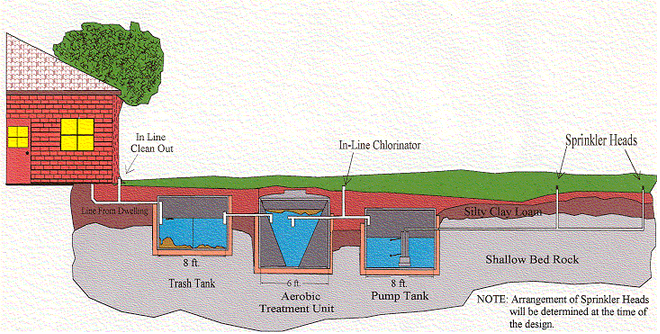How Does A Septic System Work?
Septic systems are underground wastewater treatment structures, commonly used in rural areas without centralized sewer systems. They use a combination of nature and proven technology to treat wastewater from household plumbing produced by bathrooms, kitchen drains, and laundry.
A typical septic system consists of a septic tank and a drainfield, or soil absorption field.
The septic tank digests organic matter and separates floatable matter (e.g., oils and grease) and solids from the wastewater. Soil-based systems discharge the liquid (known as effluent) from the septic tank into a series of perforated pipes buried in a leach field, chambers, or other special units designed to slowly release the effluent into the soil.
Alternative systems use pumps or gravity to help septic tank effluent trickle through sand, organic matter (e.g., peat and sawdust), constructed wetlands, or other media to remove or neutralize pollutants like disease-causing pathogens, nitrogen, phosphorus, and other contaminants. Some alternative systems are designed to evaporate wastewater or disinfect it before it is discharged to the soil.
Specifically, this is how a typical conventional septic system works:
1. All water runs out of your house from one main drainage pipe into a septic tank.
2. The septic tank is a buried, water-tight container usually made of concrete, fiberglass, or polyethylene. Its job is to hold the wastewater long enough to allow solids to settle down to the bottom forming sludge, while the oil and grease floats to the top as scum. Compartments and a T-shaped outlet prevent the sludge and scum from leaving the tank and traveling into the drainfield area.
3. The liquid wastewater (effluent) then exits the tank into the drainfield.
4. The drainfield is a shallow, covered, excavation made in unsaturated soil. Pretreated wastewater is discharged through piping onto porous surfaces that allow wastewater to filter though the soil. The soil accepts, treats, and disperses wastewater as it percolates through the soil, ultimately discharging to groundwater. If the drainfield is overloaded with too much liquid, it can flood, causing sewage to flow to the ground surface or create backups in toilets and sinks.
5. Finally, the wastewater percolates into the soil, naturally removing harmful coliform bacteria, viruses and nutrients. Coliform bacteria is a group of bacteria predominantly inhabiting the intestines of humans or other warm-blooded animals. It is an indicator of human fecal contamination.
Other Common Questions
+ Do you have a septic system?
You may already know you have a septic system. If you do not know, here are tell-tale signs that you probably do:
You use well water.
The waterline coming into your home does not have a meter.
You show a “$0.00 Sewer Amount Charged” on your water bill or property tax bill.
Your neighbors have a septic system.
+ How to find your septic system?
Once you have determined that you have a septic system, you can find it by:
• Looking on your home’s “as built” drawing.
• Checking your yard for lids and manhole covers.
• Contacting a septic system service provider to help you locate it.
+ Failure Symptoms: Mind The Signs!
A foul odor is not always the first sign of a malfunctioning septic system. Call a septic professional if you notice any of the following:
• Bright green, spongy grass on the drainfield, especially during dry weather.
• Pooling water or muddy soil around your septic system.
• A strong odor around the septic tank and drainfield.




